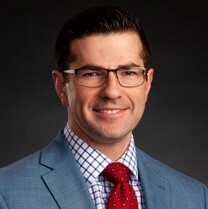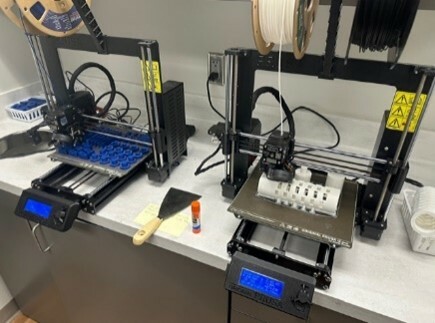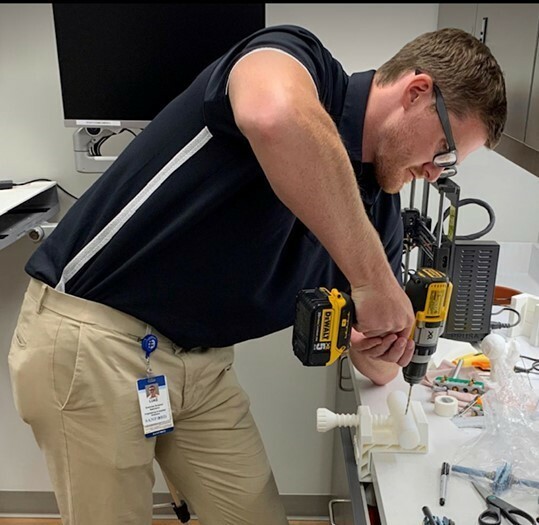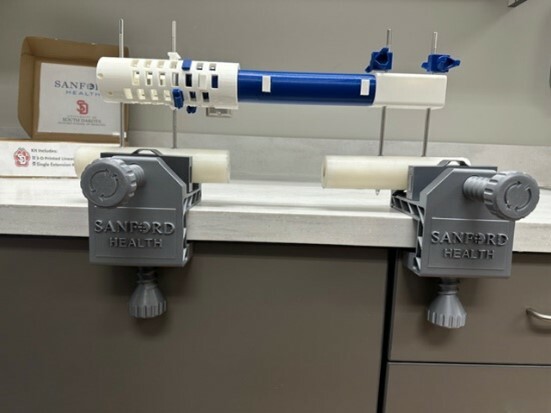
In 2021, I was honored to receive the Aircast Foundation’s Playmaker Grant during the AOSSM Annual Meeting.
The Sanford Health administration was also very excited to hear about this funding, and worked to convert the cast room into a unique research lab capable of housing the 3D printers needed for the study.

We have now developed a partnership between Sanford Health and PRUSA Research in the Czech Republic. PRUSA manufactures the 3D printers and filament we use in the study and has greatly appreciated our contributions. We will be one of the first institutions in the world to get the new XL printer with six extruder filament heads and look forward to providing the company with initial feedback to inform further development.
A component of our Playmaker Grant was creating videos to educate patients and clinical specialists on how to use our 3D printed knee device. From these videos, we developed the skills and knowledge to make medical education videos. Visit the Sanford Health/University of South Dakota’s dedicated channel on Vumedi to view the library, which has received over 50,000 views globally.
The University of South Dakota has had so many medical students working in our lab that they created an innovative new curriculum for 3D printing in medicine to help medical students learn how to create anatomical models and incorporate them into clinical practice. Utilizing the Playmaker lab to learn medical 3D printing has been a phenomenal experience for the USD medical students. They are able to incorporate these models into patient education, simulation, research and surgical training. Any surgeon at our institution can request an anatomic model and the USD medical students can make it for them. A downstream benefit of this program is that it facilitates education and interaction between surgeons and medical students. The students are also gaining a skill they can take with them beyond training and into clinical practice.

The demand for filament has increased so much that we obtained a filament recycler from Italy. We are the only location in the upper Midwest that has a filament recycler which greatly helps reduce costs and lowers our environmental impact.
Many of our surgeons work with the humanitarian medical group SIGN Fracture Care International. One year ago, we were inspired by SIGN to create an orthopedic innovation challenge across our Sanford Health Enterprise to design a new low-cost external fixator for fracture care. Surgeons across the region developed numerous ideas for this common problem. Most submissions were based around materials you would find at a big-box hardware store—compare that to a medical-grade external fixator device, which can cost $3,000-$6,000 per surgical case. By having the Playmaker 3D printers, my team was able to obtain a new institutional grant from USD to explore 3D printing an external fixator. Our work has allowed for multiple publications and presentations from the Playmaker lab space.

We recently completed a mechanical test comparing our 3D printed external fixator device to the industry standard stainless steel and carbon fiber devices. The USD device outperformed some of these devices on the tests. Unfortunately, we did not have an Instron or material testing machine capable of performing these mechanical tests in our lab because they needed a very large load cell. Therefore, we partnered with an international manufacturing company and engineering leader in Sioux Falls called Viaflex. Viaflex has been a phenomenal research partner and collaborator. Viaflex provided the equipment, expertise, and time necessary to do these tests. Their engineers greatly enjoyed helping with this project and orthopaedic work. Of note, our device costs less than $10 to print and can be assembled with only a hammer. This research has implications for long-duration spaceflight, forward-operating military units, and remote locations where people do not have access to orthopaedic care.
The Playmaker lab space has become so popular among other surgeons that we recently created a campaign to contribute orthopaedic textbooks to the space. The new library currently has 55 textbooks donated for surgeons, nurses, advanced practice practitioners, imagining technicians and students (many of whom use the Playmaker lab as their touchdown or office space during orthopaedic rotations).
The benefits of the Playmaker Grant have been extensive and amazing. We are extremely grateful for new programs, new research projects, and regional and international collaborations we have created with the Aircast Foundation’s support. We look forward to many new opportunities for our orthopedic group and the patients and students in our medical region. Thank you to everyone involved with the Aircast Foundation!

